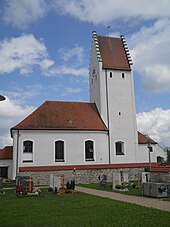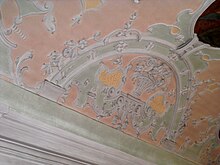St. Ulrich (Kevenhüll)
The Catholic parish church of St. Ulrich is located in Kevenhüll , a municipality part of the city of Beilngries in the Upper Bavarian district of Eichstätt . It is a baroque church in a former fortified church of the Eichstätt diocese .
location
The church is in an east-west orientation in the center of the village.
Parish history
In 1072, during the Romanesque period , the Eichstatt Bishop Gundekar II consecrated a church in Kevenhüll. It probably belonged to the local nobility and probably took up the ground floor of the residential and defense tower of the noble family (today the church tower).
In 1406 there is talk of a renewed church consecration. In 1408 the village with its Gothic church became a branch of the parish of St. Walburga in Beilngries, which was incorporated into the Plankstetten Benedictine monastery. In 1411 the monastery in Kevenhüll established an early mass; the right of patronage for this was confirmed by the episcopal visitor Vogt in 1480. A secular priest was appointed as the early knife. From 1496 Kevenhüll had quasi-parish rights. In 1518 there is talk of an Ottmaringen parish in Kevenhüll; the early knife there also provided pastoral care to Kevenhüll. A Benedictine priest von Plankstetten is named as clergyman for Kevenhüll for 1636 and around 1678; pastoring took place from the monastery. The parish registers of Kevenhüller begin in 1642. From 1713 a priest of the Plankstetten monastery took over pastoral care on site; the monastery built a parsonage for him. The church was rebuilt in 1739/40 with the participation of the Plankstetten monastery.
After the secularization and the resulting dissolution of the monastery in 1806, the parish looked after a Plankstetter pater as an exconventual until 1829. Thereafter, secular clergy pastorsed the parish curate of Kevenhüll, which was elevated to an independent parish in 1864 . Since 1968 the parish has been cared for by the Plankstetten Monastery again; in the same year a new rectory was built.
Today's church
The single-aisled church with a western sign was built in 1739/40 in the Baroque style using the medieval tower; the inauguration took place on June 20, 1752. The undivided tower with a stepped gable and saddle roof stands in the east of the church and houses the square choir in the basement. There is an annex to the sacristy to the east of the choir . The rectangular nave with three window axes measures 9 × 15 meters; its corners are rounded inwards. The organ gallery is located in the western part of the nave.
The walling of the fortified cemetery, which is still known from the beginning of the 17th century, has not existed since 1894/99; the cemetery has been walled up ever since. The former gate tower was also demolished. There are also no more traces of the Gaden , the small storage houses that leaned against the Bering within the fortified church complex. Exterior renovations of the church took place in 1971/72 and 1991/92.
Furnishing
The choir and nave of the church are baroque stuccoed with ribbon work and flower baskets. The ceiling of the nave shows two large and 16 smaller medallion-shaped frescoes from 1749. They were painted by Johann Dominikus Murmann using copperplate engravings by Johann Georg Bergmüller . Later "defaced repairs" were reversed during an interior renovation in 1988/89. The ceiling frescos show the Assumption of Mary and the church patron at the battle of the Lechfeld in 955. The medallions depict the Twelve Apostles and the four church fathers Gregor, Hieronymus, Ambrosius and Augustinus.
The altars with their shrine figures and the pulpit are also baroque. The high altar has six columns; the design of the side altars, each with four columns, is adapted to the rounded corners of the nave. The high altar picture shows the church patron with the Ulrich cross; the flanking statues represent St. Franz Xavier (right) and St. Johannes Nepomuk (left). In the excerpt, which is flanked by two angels, is the Christ monogram " IHS ", surrounded by seven putti and illuminated from behind by a stained glass window. Above the tabernacle, a pelican is feeding its young - a symbol of the Eucharist ; An angel holding a candle kneels to the right and left of the tabernacle. The side altars each have four columns; in the right altar there is a figure of St. Sebastian, in the left a crowned Madonna with the baby Jesus.
The side walls of the nave are structured by pilasters , the windows are framed with stucco. On the pulpit, on the back wall, hangs a relief representation of the Visitation of Mary from the year 1520. On the sound cover, an angel shows ten Roman numerals on two panels as a symbol for the Ten Commandments . In the right back of the nave there are figures of St. Florian and St. Wendelin attached; between them hangs a painting that the salvation of a soul from purgatory shows. Alfred Theiner from Unterhaching painted the Stations of the Cross in 1967 . The organ, installed in 1908 and repaired in 1979, has seven registers .
Four bells hang in the church tower, three euphon bells from 1950 and the smallest, the bronze Ulrichs bell, cast by Wolfgang Hieronymus Heroldt in Nuremberg in 1689.
Others
In 1843 an adoration brotherhood "Herz Mariä" was founded, in 1908 a brotherhood of the Sacred Heart of Jesus was founded. In 1888 the parish founded a parament association. The former schoolhouse has been used as a kindergarten since 1974.
literature
- Friedrich Hermann Hofmann and Felix Mader (editor): The art monuments of Upper Palatinate & Regensburg. XII District Office Beilngries. I. District Court of Beilngries. Munich: R. Oldenbourg Verlag 1908 (reprint 1982, ISBN 3-486-50442-8 ), p. 99f.
- Petrus Bauer: The Plankstetten Benedictine Abbey in the past and present. Plankstetten: Benedictine Abbey, 1979
- Parish Church of St. Ulrich Kevenhüll . (Information leaflet posted in church, around 1989)
- Emanuel Braun: The Diocesan Museum Eichstätt. Report for the years 1983 to 1989 . In: Collective sheet of the historical association Eichstätt 83 (1990), esp. P. 102
- Kevenhüll. City of Beilngries. (Information board in place)
Web links
Individual evidence
- ↑ Hofmann / Mader, p. 99
- ↑ Information board in place
- ↑ a b c d Hofmann / Mader, p. 100
- ↑ a b c d e f g h Information sheet in the church
- ↑ Bauer, Plankstetten Benedictine Abbey, p. 19
- ↑ Bauer, Plankstetten Benedictine Abbey, pp. 42, 51, 65
- ^ Bauer, Plankstetten Benedictine Monastery, p. 65
- ^ Bauer, Plankstetten Benedictine Abbey, p. 73
- ↑ Collection sheet of the Histor. Eichstätt Association 92/93 (1999/2000), p. 296
- ↑ Braun, p. 102
Coordinates: 49 ° 3 '28.1 " N , 11 ° 30' 57.8" E







